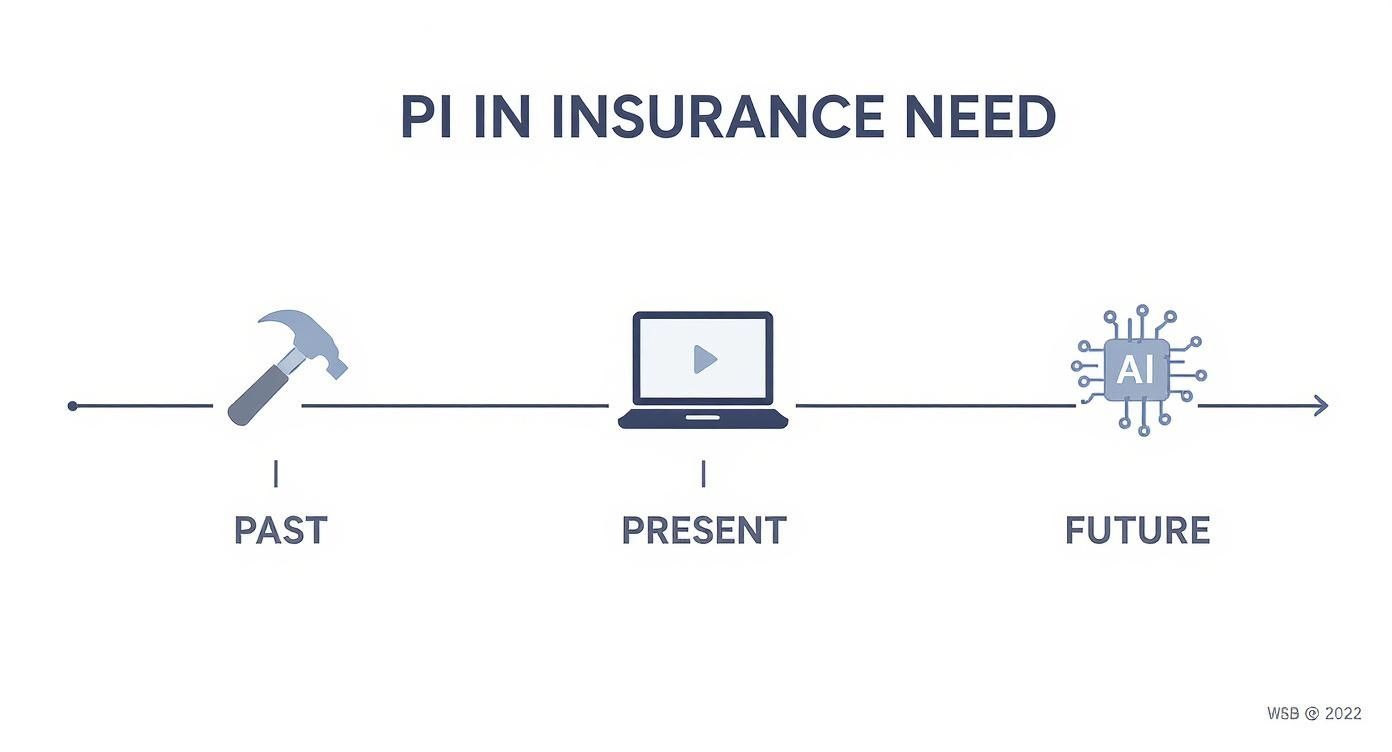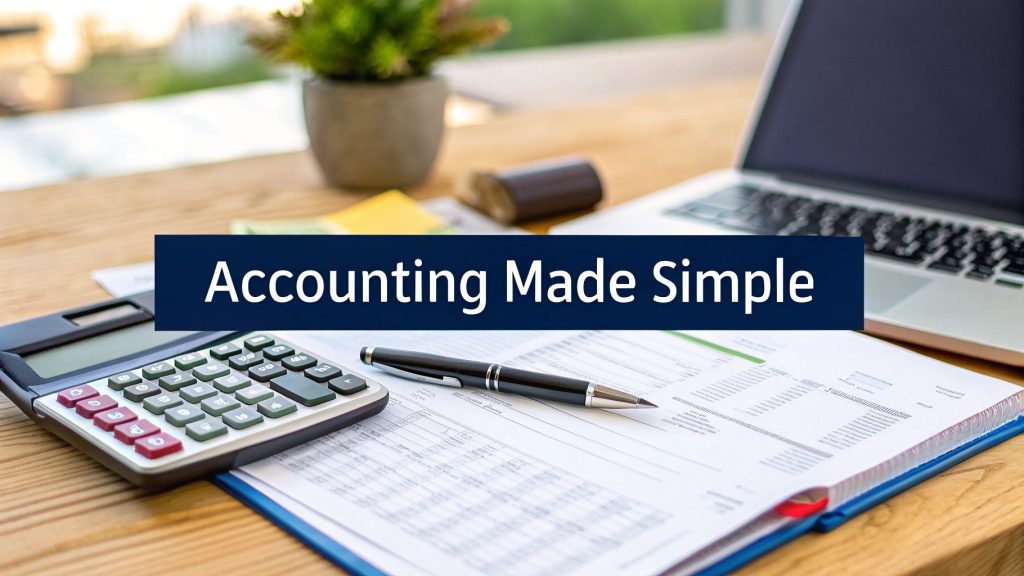What is professional indemnity insurance
what is professional indemnity insurance? – If you sell your expertise for a living, what happens when that expertise leads to a costly mistake? That’s the exact question professional indemnity (PI) insurance is designed to answer.
Think of it as a financial shield for your advice and services. It’s built to cover your business if a client claims they’ve lost money because of your professional negligence, errors, or omissions. In short, it protects you from the eye-watering legal costs that can follow a mistake or even just an accusation of one.
Breaking Down Professional Indemnity Insurance

Imagine PI insurance as a ‘rewind button’ for professional slip-ups. We all aim for perfection, but let’s be honest, mistakes happen. Whether you’re a marketing consultant, an architect, or a web developer, your services are built on specialised knowledge. If that knowledge somehow causes a client financial harm, you could be held liable.
This isn’t just for traditional roles like solicitors or accountants anymore. The UK’s professional indemnity market has ballooned to around £3.3 billion, now covering an estimated 1.5 million policyholders. This surge is largely thanks to the explosion in freelance roles and self-employment. You can explore more about the professional indemnity market to get a sense of its sheer scale.
To help break this down, here’s a quick overview of the core ideas behind PI cover.
Professional Indemnity Insurance At a Glance
This table simplifies the key concepts you’ll encounter when looking at a PI policy.
| Concept | Simple Explanation | Practical Example |
|---|---|---|
| Negligence | You failed to provide the standard of care expected of a professional in your field. | An architect’s design contains a flaw that makes a building unsafe, requiring costly repairs. |
| Errors & Omissions | You made a mistake (an error) or forgot to do something important (an omission). | A web developer forgets to renew a client’s domain name (an omission), causing the website to go offline and lose sales. |
| Indemnity Limit | The maximum amount your insurer will pay out for a single claim or over the policy year. | If your limit is £1 million and a claim costs £1.2 million, you are personally liable for the £200,000 shortfall. |
| Retroactive Date | The date from which your past work is covered by your new policy. | You buy a policy today with a retroactive date of 1 Jan 2020. It covers claims made today about work you did after that date. |
Understanding these terms is the first step to making sure you’re properly protected.
A Practical Example of PI Insurance in Action
Let’s put this into a real-world scenario. A marketing consultant is hired to launch a new product. They advise their client to pour the entire budget into a specific social media platform, forecasting huge returns.
Unfortunately, the campaign bombs, generating almost no sales and leaving the client with a massive financial hole.
Feeling they were given negligent advice, the client decides to sue the consultant to recover their losses. This is exactly where professional indemnity insurance kicks in.
Without it, the consultant is facing:
- Massive legal fees just to mount a defence.
- A huge compensation payout if the court agrees with the client.
- Irreparable damage to their business reputation and personal finances.
With a PI policy, the insurer steps in to handle the legal defence costs and any settlement or compensation awarded, right up to the policy limit. This protection is a lifeline for anyone whose business involves giving advice, offering a service, or creating designs.
Think of it this way: Your expertise is your most valuable asset. Professional indemnity insurance is the policy that protects that asset from the financial fallout of human error. It ensures one bad day doesn’t sink your entire business.
Ultimately, understanding what professional indemnity insurance is boils down to recognising your own professional risk. It gives you the confidence to do great work, knowing you have a safety net if things go wrong.
Who Actually Needs This Insurance Coverage
Now that we’ve got a handle on what professional indemnity insurance is, the next obvious question is, who actually needs it?
The simple answer is this: if you provide professional advice, services, or designs to clients for a fee, you’re exposed to risk. A small mistake, an accidental omission, or even just a client who’s unhappy with the outcome can quickly spiral into a costly legal claim.
Historically, this type of insurance was mainly for the “traditional” professions, where industry bodies often make it a mandatory requirement. But the modern economy, with its explosion of freelancers, consultants, and digital experts, has dramatically expanded the list of people who need this protection.
Traditional Professions with Mandatory Requirements
For some long-established professions, having professional indemnity (PI) insurance isn’t just a good idea—it’s a non-negotiable part of doing business. Regulatory bodies across the UK mandate this cover to protect the public and uphold professional standards. If you work in these fields, you simply don’t have a choice.
A few classic examples include:
- Solicitors and Legal Professionals: They provide advice that can have huge financial and personal consequences, making insurance an absolute must. For example, a conveyancing solicitor might miss a crucial detail in a property search, leading to a client buying a house with an unresolved legal dispute.
- Accountants and Financial Advisers: A simple calculation error or a piece of poor investment advice could lead to major financial losses for a client, sparking a negligence claim. For instance, an accountant could miscalculate a company’s tax liability, resulting in significant fines from HMRC.
- Architects and Engineers: Mistakes in their designs can cause eye-watering structural issues, project delays, and budget blowouts, making them prime candidates for claims. A structural engineer’s miscalculation could lead to a building foundation needing to be completely re-laid, costing hundreds of thousands.
These roles come with a heavy dose of responsibility, and their governing bodies insist on PI insurance to make sure there’s a financial safety net if things go wrong.
The Modern Workforce: Freelancers and Consultants
The need for professional indemnity insurance now stretches far beyond these traditional roles. The rise of the gig economy means more and more people are selling their expertise directly to clients, putting themselves on the front line.
Whether you’re a sole trader or the director of a small limited company, this cover is vital. Deciding which business structure is right for you has its own implications, and you can dive deeper in our guide on sole trader vs limited company setups to figure out what suits your operations best.
Here are just a few modern roles where PI insurance is now considered essential:
- IT Consultants and Contractors: An IT pro might recommend a new software system that fails to integrate, knocking a client’s entire sales operation offline for a day. The claim for lost revenue could be massive.
- Marketing and Advertising Agencies: Imagine a marketing agency launches a campaign that accidentally infringes on another company’s trademark. That could lead to an immediate and expensive lawsuit.
- Graphic and Web Designers: A freelance designer creates a slick new logo for a startup, only for the client to get sued because the design is a bit too similar to a major competitor’s branding.
- Business and Life Coaches: A business coach provides restructuring advice that leads to a drop in the client’s profits. The client then sues for the financial damage they believe was caused by that guidance.
In short, if your work involves intellectual output rather than a physical product, you are in the advice-giving business. This puts you directly in the line of fire for claims of professional negligence.
How to Know If You’re at Risk
Not sure if this applies to you? Ask yourself these simple questions:
- Do I provide specialist advice or services that clients rely on to make decisions?
- Could a mistake in my work cause a client to lose money?
- Do I handle client data or intellectual property?
- Do my client contracts require me to have this type of insurance?
If you answered “yes” to any of these, you’re carrying a professional risk that PI insurance is specifically designed to cover. It’s there to protect your business, your reputation, and ultimately, your personal assets from the devastating financial fallout of a claim.
Understanding Your Professional Indemnity Coverage
When you buy a professional indemnity (PI) policy, you’re not just getting a piece of paper. You’re investing in a financial shield for your business, designed to protect you from the fallout when your professional services or advice go wrong. But what does that mean in practice?
At its heart, PI insurance is there to handle the legal costs and any compensation you have to pay when a client claims they’ve suffered a financial loss because of your work. Let’s unpack what typically falls under this protective umbrella.
Core Areas of Protection
Your policy is built to respond when specific allegations are made against you. While the exact wording might differ between insurers, the cover generally handles these fundamental risks:
- Professional Negligence: This is the big one and the most common reason for a PI claim. It covers you if a client argues your work was sloppy, contained mistakes, or simply wasn’t up to the expected professional standard, causing them to lose money. Think of an accountant who makes a calculation error on a tax return, leading to a hefty fine for their client. That’s a classic case of negligence.
- Intellectual Property Infringement: This protects you if you’re accused of accidentally using copyrighted material, trademarks, or patented designs without permission. Imagine a graphic designer who creates a logo for a client that turns out to be a bit too similar to an existing one, sparking a legal threat. Your PI cover would step in here.
- Defamation, Slander, and Libel: This is essential if your work involves creating or publishing content. What if a blog post you write for a client contains statements that another company claims are false and have damaged their reputation? Defamation cover would handle the legal fees to defend you against claims of libel (written) or slander (spoken).
- Breach of Confidentiality: As a professional, you’re often trusted with sensitive client information. If you or an employee accidentally leaks confidential data—like a client list or details of a secret project—this part of your policy would cover the legal chaos that follows.
The need for this kind of protection has only grown as professional services have moved from paper-based work to digital platforms and now into AI-driven solutions.
This infographic shows just how much the nature of professional risk has changed over time, highlighting why PI insurance remains so critical.

As the timeline illustrates, the tools we use might change, but the fundamental risk of a professional mistake causing a financial loss is a constant threat.
The Claims-Made Basis Explained
One of the most crucial—and often misunderstood—parts of professional indemnity insurance is that policies operate on a “claims-made” basis. This is a critical detail that trips up many business owners.
Simply put, for a claim to be covered, your policy must be active when the claim is made against you, not necessarily when you did the original work. This is very different from “claims-occurring” policies (like your car insurance), which cover incidents that happen during the policy period, no matter when the claim is eventually filed.
This means you must maintain continuous PI cover to protect yourself from claims related to work you’ve done in the past. Even a small gap in your insurance history can leave you completely exposed.
Common Exclusions: What Is Not Covered
Understanding your policy also means knowing its limits. PI insurance is specific and doesn’t cover every risk your business might face. Some common exclusions include:
- Intentional Illegal Acts: If you knowingly break the law or commit fraud, your insurance won’t protect you.
- Bodily Injury or Property Damage: These incidents are what Public Liability insurance is for, not PI.
- Employment Disputes: Claims from employees about things like unfair dismissal or harassment are covered by Employment Practices Liability insurance.
These exclusions don’t mean the policy is weak; they just define its purpose. Knowing what is and isn’t covered is a key part of building your guide to a business risk management framework.
Given that professional indemnity-related issues are the most common type of business insurance claim in the UK, accounting for over one-quarter (26%) of all claims paid each year, this cover is clearly central to managing professional risk. The sheer volume of these claims highlights just how important it is to have a policy that tackles negligence and errors head-on.
Real-World Examples of Insurance Claims in Action

It’s one thing to talk about risks like “negligence” and “infringement” in theory. It’s another thing entirely to see how they play out in the real world. To really grasp why professional indemnity (PI) insurance is so vital, you need to see what happens when things go wrong.
These examples show just how quickly a simple professional mistake can spiral into a costly claim, and why PI insurance is the safety net that can stop a business from going under. Let’s look at three scenarios from completely different industries.
The Architect and the Costly Design Flaw
An architect is hired to design a small commercial building. Her plans look great, they get approved, and the builders get to work. But halfway through the project, the contractor hits a major snag. There’s a serious error in the structural calculations for the roof supports.
This isn’t a minor typo. The mistake means the roof, as designed, won’t be able to handle heavy rain or snow—a massive safety risk. Fixing it requires dismantling a large section of the newly built structure and rebuilding it with stronger materials. The cost? An extra £85,000 and a two-month delay.
The client is furious, and understandably so. They launch a professional negligence claim against the architect to recover the full cost of the remedial work. This is where the architect’s PI policy kicks in, covering:
- Legal Defence: The insurer appoints and pays for solicitors to manage the entire claim.
- Settlement: After negotiations, the insurer pays the agreed settlement to the client, covering the £85,000 needed for the repairs.
Without that policy, a single calculation error could easily have bankrupted her entire firm.
The Marketing Agency and the Copyright Breach
A digital marketing agency lands a contract to create a social media campaign for a new drinks brand. Working to a tight deadline, a junior designer finds a fantastic, high-energy photo online and makes it the centrepiece of the campaign.
The campaign is a smash hit. Then, a month later, a cease-and-desist letter arrives. The photograph belonged to a professional photographer, and the agency used it without buying a licence. The photographer sues both the agency and their client for copyright infringement, demanding £20,000 in damages and licensing fees.
This is a classic PI scenario. The policy responds by covering the intellectual property infringement claim. It pays for the legal fees to defend the agency and ultimately covers the settlement paid to the photographer. A simple mistake was prevented from causing huge financial and reputational damage.
A professional indemnity policy isn’t just for when you are wrong. It’s also there to defend you when you are accused of being wrong, covering legal costs even if a claim is ultimately baseless.
The Financial Consultant and the Flawed Projections
A financial consultant is advising a client on where to invest a large chunk of his retirement savings. The consultant presents detailed financial projections that show strong potential returns from a specific investment fund. Trusting this advice, the client invests £100,000.
A year later, the fund has performed terribly, and the client’s investment has lost more than half its value. The client gets a second opinion, and his new adviser discovers the original projections were based on out-of-date information and failed to account for several well-publicised market risks.
The client sues the consultant for negligence, claiming the bad advice directly caused his financial loss of over £50,000. The consultant’s PI insurance steps in immediately to manage the claim, covering the hefty legal costs and, eventually, the compensation paid to the client. It’s a perfect example of how vital this cover is for any professional whose advice has a direct financial impact on others.
How Insurers Calculate Your Premium Cost
Ever wondered how insurers land on a specific price for your professional indemnity (PI) policy? It’s not just a number plucked from thin air. The final figure is a carefully calculated reflection of your business’s unique risk profile.
At its heart, the calculation is simple: the insurer is weighing up the likelihood of a claim being made against you, and how much it could cost them if it happens. Think of it like this: an architect designing a multi-million-pound skyscraper faces a monumental level of risk. A tiny error in their plans could lead to catastrophic financial losses. In contrast, a freelance proofreader checking a blog post carries far less financial risk. While a mistake is still possible, the potential fallout is on a completely different scale.
This fundamental difference in risk is what drives the cost of your premium.
Key Factors That Drive Your Premium
Insurers look at several key variables to build a picture of your business. Each factor acts like a lever, moving your premium up or down.
The most influential ones are:
- Your Profession: This is the big one. High-risk professions where mistakes can have severe financial consequences—think accountants, architects, or financial advisers—will always attract higher premiums. Lower-risk roles like copywriting or graphic design, where the potential for a huge financial loss is smaller, will naturally cost less to insure.
- Level of Cover (Indemnity Limit): This is straightforward—the more cover you need, the more you’ll pay. A business requiring £5 million in protection is a much bigger potential liability for an insurer than a sole trader who only needs £250,000 of cover.
- Annual Turnover: Your turnover gives insurers a sense of the scale of your operations. A higher turnover usually suggests you’re working on larger, more valuable projects, which increases the potential for an expensive claim if something goes wrong.
- Claims History: A clean track record is your best friend. Having no previous claims shows insurers that you’re a well-managed risk. On the flip side, if you’ve made claims in the past, you’ll be seen as a higher risk, and your premium will likely reflect that.
A Look at the Numbers: How Premiums Vary
To put this into perspective, let’s look at a couple of real-world scenarios.
A freelance copywriter turning over £40,000 a year and needing £250,000 of PI cover might pay a relatively low premium, perhaps just a few hundred pounds. Their work is important, but a mistake is unlikely to lead to a client losing millions.
Now, consider a small IT consultancy with a turnover of £500,000. They need £2 million in cover because they manage critical systems for their clients. A single mistake could cause a company’s entire operation to grind to a halt, leading to massive losses. Their premium will be significantly higher to reflect that greater risk.
Your premium isn’t just a random fee; it’s a direct reflection of your business’s risk profile. And the good news? You have more control over it than you might think.
The cost of your policy is shaped by a handful of core elements, as insurers need to understand the specifics of your business to offer a fair price.
Key Factors Influencing Your PI Insurance Premium
Here’s a breakdown of the main drivers that insurers look at when calculating your premium.
| Factor | Why It Affects Your Premium | Example |
|---|---|---|
| Profession & Industry | Some industries inherently carry higher risks of causing financial loss. | An architect faces higher risks (and premiums) than a photographer. |
| Level of Cover | The higher the limit of indemnity you choose, the greater the insurer’s potential payout. | A policy with a £2 million limit will cost more than one with a £500,000 limit. |
| Annual Turnover | Higher turnover often correlates with larger contracts and greater financial exposure. | A firm with £1 million turnover suggests bigger clients than one with £50,000. |
| Claims History | A history of past claims indicates a higher probability of future claims. | A clean record will lead to a lower premium than if you’ve claimed twice in five years. |
| Contractual Requirements | Clients may contractually require you to hold a specific, high level of cover. | A government contract might demand £10 million of cover, pushing your premium up. |
| Retroactive Cover | Covering work done in the past adds to the insurer’s risk exposure. | Including five years of past work is riskier (and costlier) than covering future work only. |
By understanding these factors, you can start to see where you might be able to make changes to positively influence your premium.
It’s also worth noting that after a period of rising costs, the UK’s professional indemnity market has softened recently. Increased competition among insurers is leading to more competitive pricing. In fact, some sectors have seen rate reductions of 5-10%, making it a good time to shop around. For a deeper dive, you can find more on UK professional indemnity market trends and how they might affect your business.
Ultimately, by managing your risks—using solid client contracts, having robust quality checks, and maintaining a clean claims record—you present your business in the best possible light and can secure a much more favourable premium.
How to Choose the Right Insurance Policy
Choosing the right professional indemnity insurance policy can feel like a final exam, but it doesn’t have to be that complicated. With a clear process, you can confidently pick cover that genuinely protects your business when you need it most. This is your practical guide to making a smart, informed decision.
Your first move is to work out what you actually need. Don’t just pick a number out of thin air; think about the absolute worst-case scenario. If a client’s project went catastrophically wrong because of a mistake you made, what would the maximum financial damage look like? That figure is your starting point for figuring out the right level of indemnity.
Key Policy Details to Scrutinise
Once you’ve got a ballpark figure for the cover you need, it’s time to get into the weeds. The small print really matters here, as it defines the true quality of your protection. Pay close attention to these three areas.
- The Indemnity Limit: This is the maximum amount your insurer will pay out for a claim. Make sure it’s high enough to cover potential legal fees and compensation, and check whether those costs are included within the limit or paid on top.
- The Policy Excess: This is the slice of the claim you have to pay yourself before the insurer steps in. A higher excess usually means a lower premium, but you need to be honest with yourself – could you comfortably afford to pay it if a claim landed tomorrow?
- Industry-Specific Clauses: Look for cover that’s been built for your profession. A web developer needs protection against data breaches, while an architect needs cover for design flaws. A generic, one-size-fits-all policy can leave you with dangerous gaps in your protection.
Choosing a policy is a balancing act between cost and coverage. The cheapest option is rarely the best one. Aim for the most appropriate protection for your specific risks, not just the lowest price tag.
Critical Questions to Ask Every Provider
Before you sign on the dotted line, you need to ask some direct questions. The answers will tell you a lot about the insurer and the quality of their service. A reputable provider will have no problem answering these clearly.
Here’s a checklist of essential questions to fire at them:
- Does this policy include a retroactive date to cover my past work?
- What is your exact process for handling a claim from start to finish?
- Are legal and defence costs included within the indemnity limit, or are they paid in addition?
- What are the key exclusions I really need to be aware of?
Finally, think about how you’re going to buy your policy. Using a specialist broker can be a huge advantage, as they have deep market expertise and can sniff out policies tailored to your industry. Buying direct from an insurer can sometimes be quicker, but the responsibility for making sure the cover is right falls squarely on your shoulders.
Whichever route you choose, remember that your first line of defence is always a rock-solid client contract. For more guidance on that, you can learn how to protect your business with contracts and agreements in our detailed article.
Your Questions Answered
When you’re digging into professional indemnity insurance, a few common questions always seem to pop up. Let’s clear them up with some straightforward answers.
What’s the Difference Between Professional Indemnity and Public Liability Insurance?
It really boils down to advice versus accidents.
Professional indemnity (PI) insurance is all about the work you do. It covers you if your professional advice, services, or designs cause a client to lose money. Imagine a business consultant whose strategy backfires, costing their client a fortune. That’s a classic PI claim.
On the other hand, public liability insurance is about physical mishaps. It steps in if your business activities cause injury to someone or damage their property. If a client visits your office, trips over a cable, and breaks their laptop, that’s a job for public liability.
Do I Still Need PI Cover If I Have a Limited Company?
Yes, absolutely. This is a common point of confusion. While setting up a limited company protects your personal assets (like your house) from business debts, it does nothing to protect the company’s assets.
If a client sues your limited company for professional negligence, the business itself is on the hook for legal defence costs and any compensation awarded. A professional indemnity policy shields the company’s bank account, ensuring a single mistake doesn’t bring the whole business down.
How Much Professional Indemnity Cover Do I Actually Need?
There’s no magic number here; the right amount of cover depends entirely on your business. To figure out what you need, think about these three things:
- Your Profession: Some fields carry more risk than others. An architect designing a multi-million-pound building needs a much higher limit than a freelance copywriter.
- Client Contracts: Pay close attention to your contracts. Many larger clients, especially in the corporate or public sector, will state a minimum level of cover you must have, which is often £1 million or more.
- Worst-Case Scenario: Be honest with yourself. What’s the biggest financial mess a mistake could create for your client? Your cover should be enough to clean it up.
What Is a Retroactive Date and Why Is It So Important?
The retroactive date is a critical detail in your policy that you can’t afford to ignore. It essentially sets a start date for your insurance, covering work you’ve done in the past. For a claim to be paid, the work that caused the issue must have been completed after this date.
Think of it like this: if you buy a policy today with a retroactive date set five years ago, you’re covered for any claims that arise now from work you did during that five-year period. Without it, only new work is protected, leaving all your past projects completely exposed.
At Grow My Acorn, we’re here to give you the clarity and confidence to manage your business risks effectively. For more practical advice to help your business grow, explore our resources at https://growmyacorn.co.uk.











































